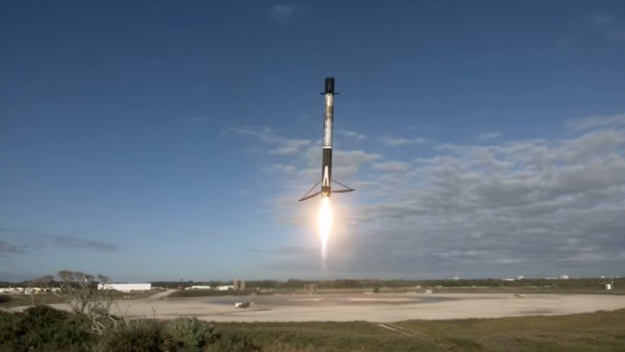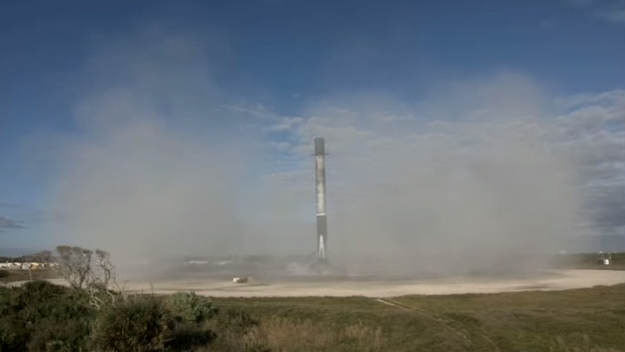SpaceX launches classified US spy satellite, sticks rocket landing to cap record year
CAPE CANAVERAL, Fla. — SpaceX launched a clandestine U.S. spy satellite into space for the National Reconnaissance Office (NRO) Saturday (Dec. 19) , marking its 26th rocket of the year.
The mysterious payload, called NROL-108, lifted off from Pad 39A here at NASA's Kennedy Space Center at 9 a.m. (1400 GMT) , during a planned three hour launch window.
A used two-stage Falcon 9 rocket carried the spy satellite aloft, as part of a government mission called NROL-108, marking SpaceX's 26th launch of 2020, a new record for the company. Approximately nine minutes after liftoff, the booster's first stage produced some dramatic sonic booms as it made its way back to terra firma, touching down at SpaceX's Landing Zone-1 (LZ-1) at the nearby Cape Canaveral Space Force Station.
Video: Watch SpaceX's epic NROL-108 Falcon 9 rocket landing
Related: See the evolution of SpaceX's rockets in pictures
Saturday's flight was the fifth launch for this particular Falcon 9 first stage. The booster, designated B1059, previously lofted two commercial cargo missions to the International Space Station for NASA, delivered a batch of SpaceX Starlink satellites into orbit earlier this year, and most recently launched an Earth-observing satellite for Argentina.
Falcon 9 blasted off into a clear blue sky Saturday morning, a stark change from Thursday’s launch attempt. Thick clouds shrouded the rocket from view that day and ultimately an issue with the rocket’s second stage forced SpaceX to postpone the launch.
Several minutes after Falcon 9 leapt off the pad, the rocket’s first stage reappeared in the sky, with the iconic sonic booms you expect cracking overhead as the booster descended to the landing site.
Get the world’s most fascinating discoveries delivered straight to your inbox.
B1059 is only the second booster to land on the ground at the Cape (as opposed to a drone ship at sea) this year. (A third landed on land at Vandenberg Air Force base in California following the launch of the Sentinel-6 Earth-observing satellite for NASA in November.) In fact, it's now the third trip to LZ-1 for this booster, as the veteran Falcon 9 first stage also returned to land after delivering the CRS-20 mission into orbit earlier this year.
Related: Hitch a ride to space (and back) on a Falcon 9 in this awesome video
A mystery payload
Saturday's Falcon 9 launch carried a classified payload into orbit for the National Reconnaissance Office (NRO), the government agency that oversees the country’s fleet of spy satellites. Not much is known about the satellite except for the fact that the NRO secured the ride for the top secret cargo through non-traditional means.
Typically, the reconnaissance agency will secure its rides to space via the U.S. Space Force's National Security Space Launch Program, but this time went about it on its own, according to a report from Spaceflight Now.
"In some cases, the NRO uses alternative methods to procure launch services after making a cumulative assessment of satellite risk tolerance, needed launch dates, available launch capabilities, and cost — all with a purpose of ensuring satellites are safely and securely delivered to orbit in a timely manner," the spokesperson told Spaceflight Now.
Another interesting twist is that SpaceX did not conduct a static fire test of its rocket before flight. Typically, the company holds the rocket down on the pad and briefly fires its nine first-stage engines to make sure their systems are working as expected prior to liftoff. It's rare that SpaceX skips this routine test but is not unheard of.
The mission marks the sixth launch of the year for the NRO, and will be the second overall to fly aboard a SpaceX Falcon 9. The first was the NROL-76 mission back in May 2017.
Falcon's flight


The NROL-108 mission is SpaceX’s 50th reflight of a Falcon 9 since the company recovered its first booster in 2015. It also marks the 70th landing of a Falcon 9. To stick the landing, the booster separated from its upper stage and conducted a series of orbital ballet moves, reorienting itself for landing. Then it conducted a series of three engine burns to slow itself enough to gently touch down on its designated landing pad, marking the 21st successful land landing for SpaceX.
To facilitate reuse, the company normally relies on its two massive drone ships, named "Of Course I Still Love You" and "Just Read the Instructions," the floating platforms are typically stationed out in the Atlantic Ocean and have enabled SpaceX to launch and subsequently land more rockets.
"Of Course I Still Love You" is sidelined for this mission, since the booster is returning to land, while "Just Read the Instructions" is currently bringing back a booster from the company's most recent launch on Dec. 13. For that mission, a Falcon 9 rocket launched for the seventh time, carrying a massive satellite into space for SIrius XM. That booster is one of two that have flown that seven missions and should be sailing back into port around the same time as Saturday's launch.
Once they return to Florida's Port Canaveral, the landed boosters are transported back to SpaceX facilities, where they're carefully inspected and repurposed to fly again.
The current iteration of the Falcon 9 was finalized in 2018. Known as the Block 5, it features 1.7 million pounds of thrust as well as some other upgrades that make it capable of rapid reuse. SpaceX says that each of these boosters can fly as many as 10 times with minor refurbishments in between, and potentially as many as 100 times before retirement.
To date, SpaceX has launched and landed the same booster a maximum of seven times. According to company founder and CEO, Elon Musk, each Falcon 9 booster is capable of flying at least 10 times with minimal refurbishments in between flights. We have yet to see one fly that many times, but could see it next year.
Rocket fairing recovery
Ahead of today's launch, SpaceX deployed one of its twin fairing catchers, GO Ms. Tree, to fetch the fairing pieces after today's launch. GO Miss Chief, the company's other fairing recovery vessel, stayed in port for the second mission in a row. These two boats act as giant, mobile catcher's mitts, snagging payload fairings — the protective nose cones that surrounds satellites during launch — in their attached nets as they fall back down to Earth.
To that end, SpaceX has installed parachutes and special software in its payload fairings, which consist of two joined pieces. The fairings are designed to guide themselves to the recovery zone where Ms. Tree and Ms. Chief can wait to snag them as they fall back to Earth. If the boats miss or the weather is too poor to attempt a catch, the duo has on board equipment to scoop the fairing pieces up out of the water and carry them back to port for refurbishment.
The company has been successfully reusing the payload fairings, and the last mission — which launched the Sirius XM-7 satellite — was the first flight to feature a refurbished fairing on a non-SpaceX payload. Typically the company has been reusing fairings on its own Starlink missions. One of the fairing pieces that shrouded the Sirius XM-7 payload as it traveled through the atmosphere previously flew on the Anasis-II mission earlier this summer, which launched a communications satellite for South Korea's military.
Today's mission will mark the end of a busy launch year for the Cape. In total 31 missions have launched from the area this year, and 26 of those have been on SpaceX rockets. Next year, SpaceX is expected to continue to fill in its fleet of Starlink satellites, launch two more astronaut missions, and one of its heavy-lifters, the Falcon Heavy.
Follow Amy Thompson on Twitter @astrogingersnap. Follow us on Twitter @Spacedotcom or Facebook.




